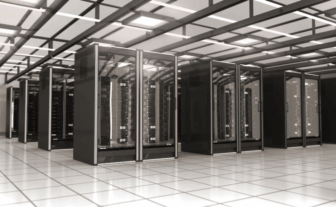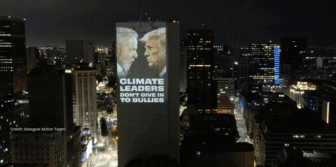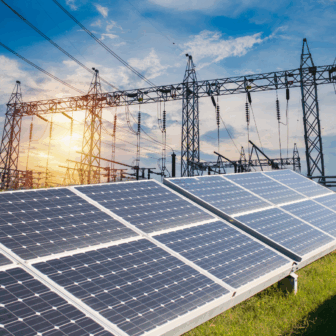By Amanda Scott
Maryland is at a crossroads between clean, renewable energy and a “radical detour,” according to Chesapeake Climate Action Network.
On Wednesday night, about 50 people attended CCAN’s town hall meeting at St. Mary’s College of Maryland as part of the organization’s nine-stop “Maryland Crossroads 2013 Tour: Clean Energy, Not Cove Point!” The purpose of the tour is “to rally public opposition” and “educate Marylanders” about Dominion’s proposed liquefied natural gas export project at its Cove Point facility in Lusby, according to a CCAN press release. CCAN is a nonprofit group whose mission is to fight global warming in the Maryland, Virginia and Washington, D.C., area. Wednesday’s meeting followed an Oct. 22 meeting CCAN held in Lusby.
“Maryland really has been, the last 10 years, on a path of transitioning off of climate-changing fossil fuels and on to clean, renewable energy,” CCAN Executive Director Mike Tidwell said. “But in the past six months, a radical detour has been proposed for our state. It’s a very different energy vision that would seriously knock us off our current path.”
One of the issues with the exportation project, Tidwell said, is that it will increase hydraulic fracturing, or “fracking,” releasing a percentage of methane into the air. He said according to the Intergovernmental Panel on Climate Change, methane is 28 times more powerful at trapping heat in the atmosphere than carbon dioxide.
“If Cove Point is built, there will be fracking in Maryland,” Tidwell said. “Does anyone think we’re going to build a $3.8 billion facility right up the road in Maryland in Calvert County to export fracked gas to the world, but we, Maryland, we won’t actually frack here in our state? Of course we will. The pressure will be enormous.”
Gov. Martin O’Malley (D) issued an executive order in 2011 that barred the Maryland Department of the Environment from approving drilling permits until a $1.5 million scientific study (due in 2014) is completed.
The pollution created from fracking (including methane) as well as the potential pollution released from liquefying and exporting natural gas (nitrous oxide, carbon dioxide, sulfur dioxide and particulate matter) will create smog, he said.
It would be the “top single source of lifecycle climate pollution in Maryland,” Tidwell said. He described the project as “a virtual pollution worst-case scenario for Maryland.”
Previously, Dominion has stated the existing facility is currently permitted to emit 1.4 million tons of carbon dioxide and has never reached that level. The company is requesting, according to Dominion, a second emissions permit to be able to emit up to 2 million tons of carbon dioxide as an export facility.
Saying no to Dominion’s proposed project, Tidwell said, is “saying yes to something much better … for the environment and jobs by taking a different point in the crossroads”: wind and solar energy.
In Maryland’s upcoming legislative session, Tidwell said CCAN is supporting legislation that would double Maryland’s clean energy use to 40 percent by 2025 instead of the currently required 20 percent by that year. Wind is Maryland’s “signature” energy source and the wind energy industry is “clamoring” to come into the state, he said.
“There’s no sea level rise that comes with wind power. Plus, you get the jobs. And, whenever there’s a huge solar energy spill, it’s called a nice day. Plus, you get the jobs,” Tidwell said.
During several discussions about the project, including Wednesday night’s, concerns have been raised about the number of “temporary workers” that will be brought to the community. According to Dominion’s reports, the construction phase will support up to 4,000 jobs for Maryland and once in-service will employ about 75 new, additional permanent employees.
He said climate scientists say clean, renewable energy sources have to be implemented faster to combat global warming.
“Let’s do it for the jobs, for health, for real energy independence … and let’s do it because without a solution to global warming, we won’t have an economy.”
During the next six to seven months, Tidwell said, Maryland has to decide if it’s going “to stay on course with bigger and better clean energy development, or are we going to take a radical detour?”
The Federal Energy Regulatory Commission, which is reviewing Dominion’s project application, already has identified several concerns regarding the expansion, according to an Oct. 18 project review update. Issues FERC is reviewing include its effects on water resources, wildlife, tree removal, road and marine traffic, property values, air and health and safety, among other impacts.
FERC will decide whether to conduct an environmental impact study when it releases its environmental assessment, FERC officials have said.
Dominion has maintained throughout the project application process that all effects will be minimal, and the company remains committed to environmental stewardship—reasons Dominion stated in its FERC application that it doesn’t feel an environmental impact study are necessary.
During the St. Mary’s meeting, Tidwell also presented several Southern Maryland residents and environmental activists with “Climate Hero” awards, including Patuxent Riverkeeper CEO Fred Tutman, Larry Tierney of California, Md., and the St. Mary’s Chapter of the Student Environmental Action Coalition.





